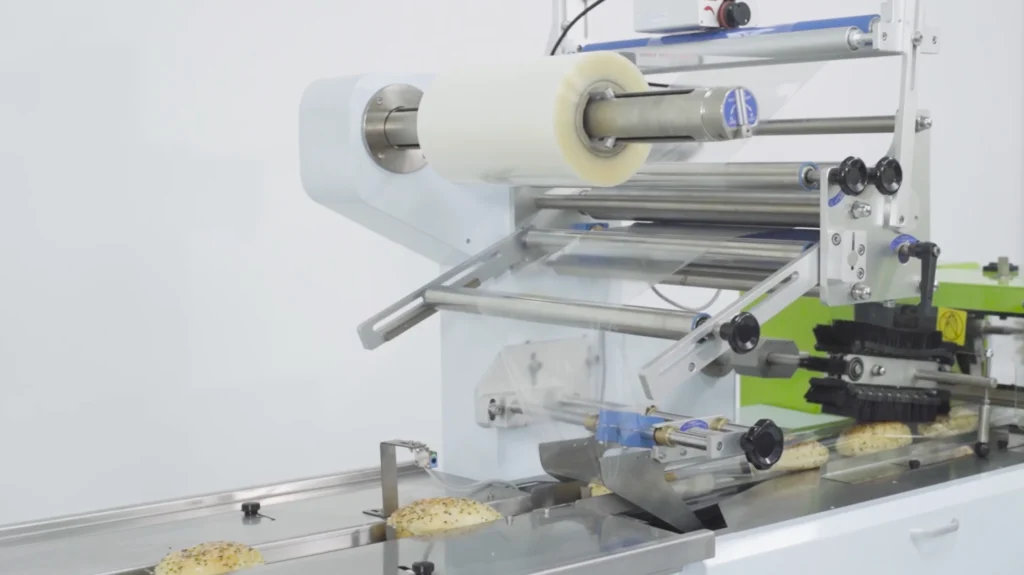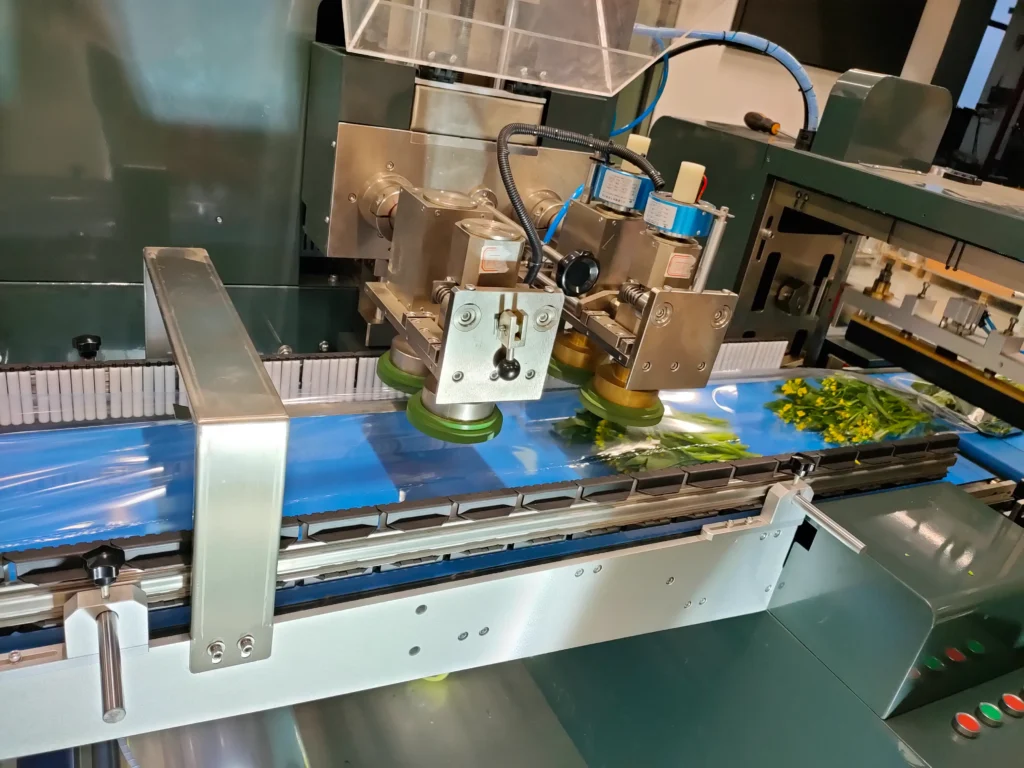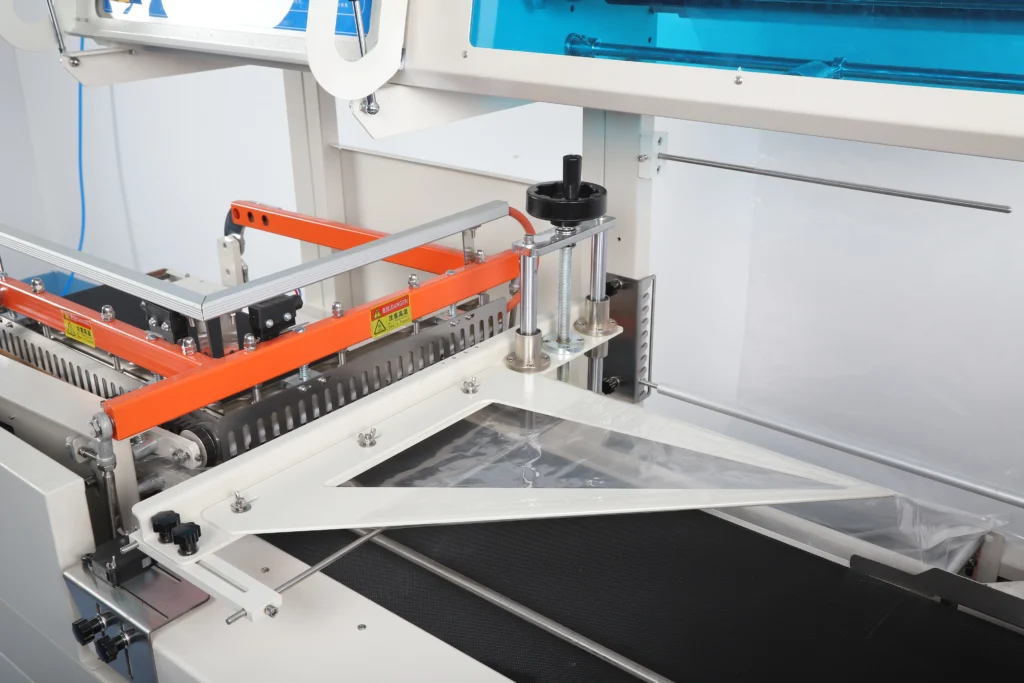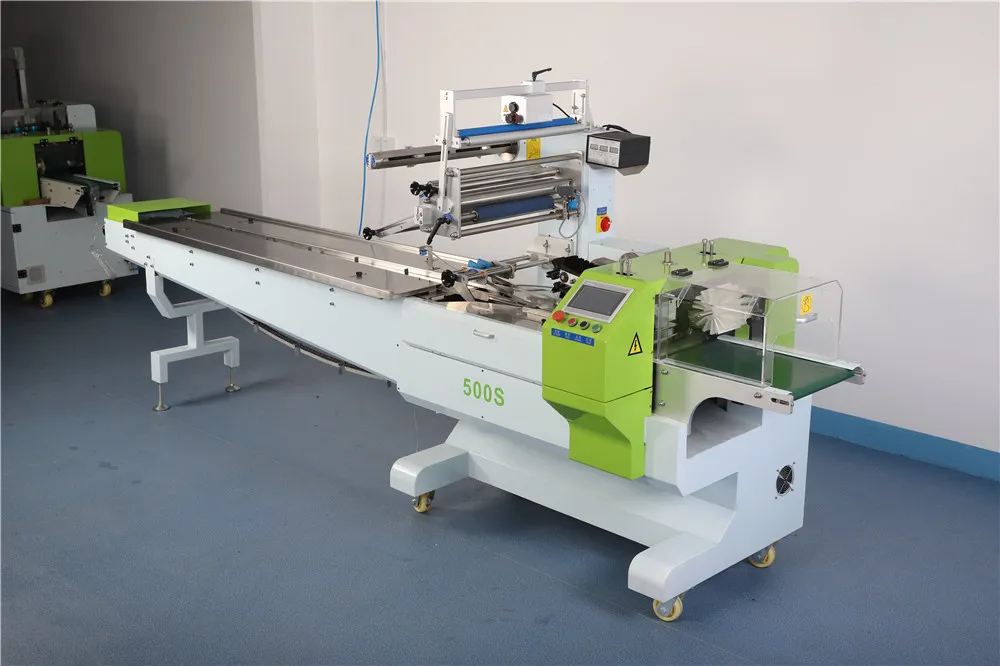The Most Comprehensive Guide to Flow Wrapping Packaging Solutions
Flow wrapping, a versatile packaging technology, transforms how products reach consumers. Billions of snack boxes, cereal bags, and more pass through flow wrappers yearly. This typical process revolutionizes packaging across industries.
In this guide, we’ll explore the magic behind flow wrapping. From films to equipment, applications to innovations, we’ll cover it all. Let’s dive into the world of flow wrapping!
Table of Contents
What is Flow Wrapping?

Flow wrapping is an automated packaging process commonly used to seal a wide variety of products in flexible plastic films or laminates.
In flow wrapping, individual items or batches of products are fed into a flow wrap machine. The machine folds the packaging material around the products and seals the overlapping edges to form a tight wrap. Excess packaging material is trimmed off to create a clean, finished look.
Flow wrapping helps many industries protect product freshness and quality. It works well for foods, medical supplies, and consumer goods that must stay sterile and safe.
The tight seal stops contamination but keeps moisture, smell, and other qualities. With high speeds and flexibility, flow wrappers allow fast, automated, high-volume packaging. This improves productivity.
Flow wrapping has become vital for retail-ready products or distribution boxes because of its quality seals, efficiency, and appearance.
Benefits of Flow Wrapping
Protects Product Integrity and Freshness
Flow wrapping seals products in an airtight package. This prevents contamination and keeps products fresh. It stops oxygen, light, and germs from getting in. Flow wrapped foods stay tasty longer. Medical supplies avoid germs. Consumer goods don’t go bad as quickly—the wrap locks in moisture, smell, and flavor.
Allows for Tamper Evidence
The tight film of flow wrapped packages shows if anyone opened them. Any tears or holes in the wrap may mean someone tampered with it. This is essential for foods, medicines, and over-the-counter drugs. Shoppers can trust flow wrapped products come safe and secure.
Allows for Attractive Packaging and Branding
With flow wrapping, products get packaged in colorful, quality films. Vibrant designs and logos can stand out. The wrap becomes a part of the brand. Shoppers can see the contents clearly. Companies make their shelf products unique with custom colors and graphics on flow wrapped packages.
Cost-effective and Efficient Packaging
Flow wrapping uses inexpensive, thin films to pack products well. Automated flow wrapping systems need little labor. They package things quickly in high volumes. The technology switches fast between products. Flow wrapping wastes minimal materials. It streamlines packaging across supply chains cost-effectively.
Accommodate Different Product Sizes and Shapes
Flow wrapping can package many product dimensions, from small candies to large bundles. Custom film sizes let unique and irregular shapes wrap neatly.
How Does Flow Wrapping Work?
Flow wrapping uses flow wrapper to wrap products in packaging film. The products move through the machine in a straight line. Here are the main steps:
Step 1: The product is placed on an infeed conveyor belt. This moves the product into the flow wrapper.
Step 2: As the conveyor moves, packaging film feeds into the forming area from a film roll.
Step 3: In the forming area, the film wraps around the product to create a tube shape. The edges align and seal together.
Step 4: The sealed film tube with the enclosed product moves to the cutting head.
Step 5: The cutting head seals the top and bottom package edges while cutting between products. This separates the individual packages.
Step 6: Finished, flow wrapped packages exit the machine through the discharge area.
Step 7: Packages can be cartoned immediately or accumulated for secondary packing.
Key Applications of Flow Wrapping
Snack Foods
Flow wrapping is commonly used for snack foods like chips, crackers, granola bars, and candy. It keeps the snacks fresh and crispy while allowing for nice package graphics. The automated process boosts production speed for high-volume snack packaging.
Baked Goods
Breads, cookies, pastries and other baked items often get flow wrapped to maintain softness. It prevents early staling and damage. Clear wrapping highlights the products inside while protecting flavor. Flow wrapping enables efficient packaging of baked goods from retail packs to bulk cases.
Fresh Produce

From cut vegetables to fresh fruit, flow wrapping prolongs shelf life for produce. It controls moisture loss and allows modified atmosphere packaging to optimize conditions. Flow wrapped produce stays fresher longer thanks to the airtight sealing. High-speed flow wrapping keeps handling minimal for freshness.
Frozen Foods
Flow wrapping is ideal for frozen meal trays, ice cream novelties, french fries and other frozen foods. It prevents freezer burn and dehydration during long frozen storage.
Healthcare Products
Sterilized medical instruments, gauze pads, surgical gowns, and more get flow wrapped to keep them sealed and contaminant-free.
Personal Care Items
Soaps, shampoos, feminine products, and cosmetics use flow wrapping to maintain freshness and prevent leaks or spills.
Hardware and Tools
Hardware items like nails, screws, and drill bits are often flow wrapped in bulk cases for protection during shipping and storage.
Types of Packaging Films for Flow Wrapping
Films by Sealing Method
Cold Seal Films
Cold seal films have a base material with a thin layer of glue. These films seal by pressing the glue layers together instead of heating them. So no welding happens. This avoids heat damage to the product. But cold sealing can’t make as strong a seal as heat sealing. The glue may also get worse if not stored right. Cold seal films often cost more too. But they can work at fast speeds for heat-sensitive things like chocolate.
Heat Seal Films
When air-tight seals are needed, heat seal films are best. The key is sealing over a wide temperature range. Even with good moisture barriers, films must seal well on the wrapper. If not, packaging and seals suffer. Some materials have great barrier properties but seal poorly. These lose out to worse barriers with good sealing.
To optimize seals, adjustments are sometimes needed. Worn equipment, voltage changes, speed changes and more can impact sealing. So seal temps must adjust for changes. Understanding how heat seals work on the films is key. This helps make the right temp adjustments for good seals.
Films by Material
Polypropylene (PP/OPP) Film
Polypropylene is a popular choice in flow wrapping. It’s commonly used to wrap snacks, candy, and baked goods.
This film has three layers: an outer layer with acrylic coating to prevent melting, a polypropylene core, and an inner sealant layer. It seals and protects against dirt, dust, moisture, and oxygen. It offers various lamination options based on your needs.
Unprinted polypropylene is clear, showing the product inside. You can get it with different sealant layers or a cold seal adhesive. Some variants, like metallocene or surlyn, seal faster.
Polypropylene films can also be combined with other materials for gas flush packaging, extending product shelf life by replacing oxygen with nitrogen or carbon dioxide to prevent mold growth.
Polyester (PET) Film
Polyester films handle high-speed applications well due to their heat resistance, unlike polypropylene. They won’t shrink under high temperatures. Light gauge polyester is the go-to for wrapping toaster pastries, safe for microwave heating. Special oven-friendly polyester is used for products like French bread and as lids for frozen trayed items. These can go straight from the freezer to the oven! For moist towelettes and baby wipes, 48-gauge polyester with an LDPE sealant layer is widely used. Polyester films can withstand temperatures up to 500°F or more.
Polyethylene (PE) film
Polyethylene (PE) film comes in three types:
Low Density Polyethylene (LDPE) is ideal for shrink applications, like wrapping pizzas and soap bars. It works on horizontal wrappers with an inside sealant layer, often using EVA. LDPE is great for packaging plastic cutlery, pharmaceutical syringes, and literature. It seals at 225°F – 250°F.
Linear Low Density Polyethylene (LLDPE) adds tear resistance in laminations and serves as a sealant layer in some films.
High Density Polyethylene (HDPE) needs a sealant layer for fin seal horizontal wrappers. It’s used as an outer layer along with LDPE and EVA sealant for products like waffles, crackers, and plastic cutlery. Sealing temperatures range from 250°F to 300°F.
Foil Laminations
Foil laminations consist of an aluminum alloy sheet, sandwiched between film layers and a sealant layer. They can have multiple layers, with varying foil thickness. Foil laminations are used for pharmaceuticals and light-sensitive items. The outer layer can be paper, polyester, nylon, polypropylene, or others. Foil laminates provide the best barrier against outside elements. Seal temperatures range from 300°F to 500°F, depending on thickness and materials. Proper sealing often requires extended dwell wrappers.
Paper/polyethylene Laminations
Paper/poly films are common for gauze bandages and frozen foods like pot pies. Some have a thin metalized “susceptor” layer to crisp food in the microwave. They’re not fast due to the paper’s insulation. Heat ranges from 350°F to 500°F, and preheating may be needed for faster production.
Valeron Film
Valeron film is known for its strong tear resistance, especially used for wrapping chlorine tablets. It’s great at keeping moisture out and is puncture-proof, meeting child-resistant requirements. However, it seals slowly, around 450 inches per minute, and has a narrow sealing temperature range, making it a bit challenging to work with.

Valeron film is known for its strong tear resistance, especially used for wrapping chlorine tablets. It’s great at keeping moisture out and is puncture-proof, meeting child-resistant requirements. However, it seals slowly, around 450 inches per minute, and has a narrow sealing temperature range, making it a bit challenging to work with.
Polyvinyl Chloride (PVC) offers high clarity and stiffness. It’s used for candles, cards, and CDs, with a static lap seal and a special PVC knife for end sealing when utmost clarity is needed.
Glassine Film
Glassine is a grease-resistant paper with a sealant layer. It’s used for items like vending machine fruit pies but is being replaced with faster, tear-resistant materials.
Factors to Consider with Flow Wrapping
Equipment
The type of flow wrapper must suit the product, speed, automation needs, and budget. Horizontal wrappers offer versatility for many applications.
Packaging Material
The film must provide needed barriers, seal strength, durability, and appearance. Material choice impacts cost, efficiency, and environmental factors.
Package Size
Will the flow wrapper handle the product dimensions and achieve the desired finished package size? Scale equipment appropriately.
Automation Level
Manual, semi-automatic, or fully automatic flow wrapping affects labor requirements, operation costs, and throughput.
Packaging Aesthetics
Printed, colored, or custom films can enhance brand image and shelf appeal. Balance visual impact with budget.
Moisture and Oxygen Barriers
Choose films with needed protection against moisture loss, oxygen exposure, aromas escaping, etc.
Budget
Weigh costs of equipment, film, changeover time, labor, maintenance, etc. Get the best value for money spent.
Flow Wrapping Equipment

Overview of Flow Wrappers
Flow wrappers are the most versatile for packaging a wide range of products. Products move in a straight line through different stations to be wrapped, sealed, cut, and discharged. Horizontal wrappers work continuously at high speeds.
Brief Pros and Cons
The benefits of flow wrappers include efficiency, automation, speed, and flexibility. Drawbacks can be higher initial costs and maintenance needs compared to other wrapping styles. Complex changeovers between products may slow things down.
Equipment Selection Factors
Key factors in choosing a flow wrapper include the product size, shape and materials, required output, film used, automation level, operator skill, and budget. Prioritize features that optimize wrapping for specific products. Get the right balance of speed, changeover ability, durability, and technical support.
Flow Wrapping Solutions from Packaim Machinery
Packaim Flow Wrapper Product Line
Packaim offers a complete range of horizontal flow wrappers for various industries. Models from entry-level economical wrappers to advanced systems with servos, and robotic loading. Packaim engineers customize wrappers for unique applications.
Advantages of Packaim Flow Wrappers
Key benefits of Packaim flow wrappers include:
- High-speed operation for maximum efficiency
- Quick changeovers between products
- Intuitive controls and easy maintenance
- Durable construction for non-stop production
- Flexibility to handle different films, packages, and products
- Turnkey integration with other packaging equipment
- Support from experienced technicians for setup and optimization
For the best flow wrapping solutions, trust the experts at Packaim Machinery to deliver the right system for your products.
Conclusion
Flow wrapping is a versatile packaging process that seals billions of food and retail items yearly. We covered how flow wrapping works, key benefits, main applications, film options, equipment, and factors to consider.
Key takeaways include:
- Flow wrapping provides efficient, high-speed packaging that maintains product freshness and quality.
- Tight seals prevent contamination while retaining moisture and aroma.
- Printed films allow for branding and visual appeal.
- Flow wrappers accommodate many products and package sizes.
- Film characteristics, automation level, budget and other factors guide equipment selection.
- Leading companies like Packaim offer customized flow wrapping solutions.
With the basics of flow wrapping technology explained you are now well-equipped to implement flow wrapping. This automated, high-volume packaging process enables productivity and quality presentation across supply chains.
Jason
I’m the author of this post, with over 10 years of expertise in the field. Should you seek insights or information about flow wrappers, I’m here to assist. Let’s connect and explore the world of packaging together.
